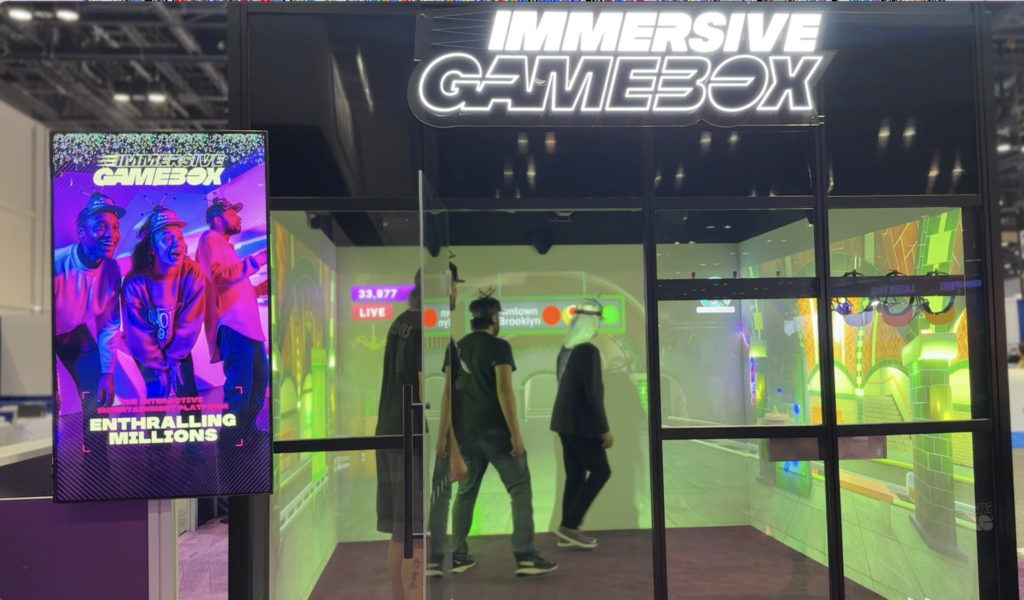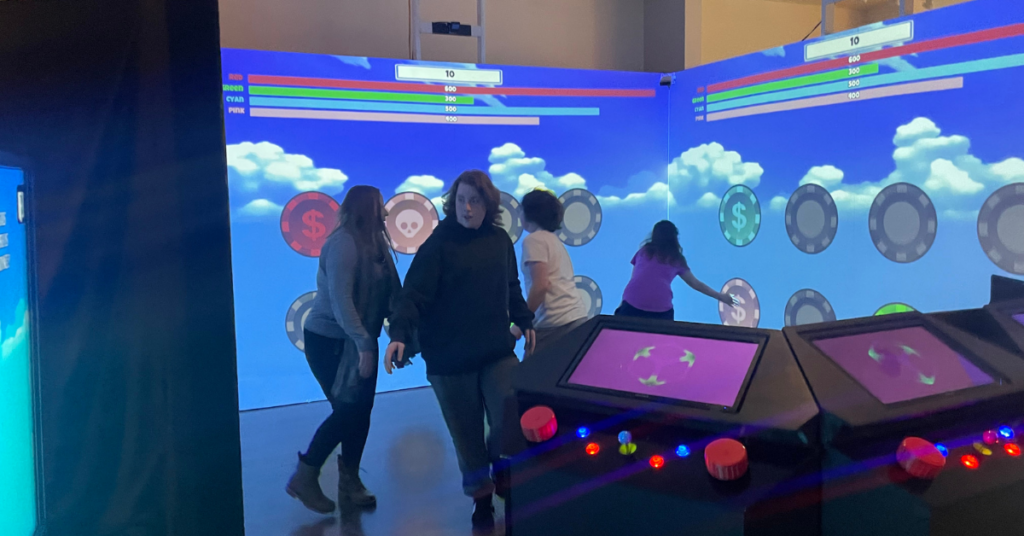What Are Interactive Gaming Rooms?

Bob Cooney
by Bob Cooney
There’s a new trend that seems to be catching fire. And while it’s not virtual reality, it is a form of immersive entertainment and uses some of the core technology from the VR industry.
Interactive Gaming Rooms are compact, multiplayer, enclosed spaces with interactive video on the walls and/or floor. They use camera systems and sensors found in free roam VR technology to track player movements and interactions with the environment.
While the technology applied might differ, the experiences all offer active shoulder-to-shoulder multiplayer games people seem to love.
 Immersive Gamebox
Immersive Gamebox
Immersive Gamebox was the first company to popularize this new segment of immersive entertainment. They started offering only a franchise model, but this year at IAAPA they offered “concessions” to FECs and other attractions that want to add gaming rooms to their attraction mix.
Immersive Gamebox has games based on Ghostbusters, Squid Games, Paw Patrol and more. Up to six players don plastic see-through visors with tracking markers. Players act like human joysticks, walking back and forth and side to side in a sometimes-vain attempt at controlling an on-screen character. The system also senses when you touch a wall so you can activate virtual buttons on screen.
I played the Ghostbusters game at IAAPA and found it frustrating trying to make a character move up and down on a screen by walking forward and backwards. It’s totally counterintuitive. My guess is if you’re drinking, and playing with friends, the goofiness could be part of the fun. But it wasn’t very immersive, because I spent all my time thinking about how to control the on-screen avatar. (Note: Since the original publication of this piece, Immersive Gamebox Co-Founder David Spindler has gotten in touch, inviting me to try the full-length experience, confident that I’d warm up easily to their control mechanism. I hope to do that and report back at a future time.)
 QBIX
QBIX
Another entrant into the Interactive Gaming Rooms market is QBIX from Inowize, the company behind the successful Arkadia VR arena. Like Immersive Gamebox, QBIX is a 6-player system with video projected onto three walls. It also adds environmental effects like wind and a vibrating haptic floor for deep immersion. QBIX players use a handheld controller to interact with the game environments. The user controls reminds me a bit of the Triotech XD Theater, where players follow their color target reticle on the screen.
QBIX currently offers three games: the requisite zombie shooter, an action/ puzzle game and an action maze chase game reminiscent of, but not as much fun as, Pac-Man. They’re in development of a fourth game: a multiplayer cooking game, that looks like a lot of fun.
QBIX is by far the most compact and affordable of the attractions in this category. It’s advertised as unattended, but speaking to some of the early operators, they’re placing it in locations where they can keep an eye on it. Good advice for any new platform.
 Dave & Buster’s Arena
Dave & Buster’s Arena
Despite the new management team’s restaurant background, they’re hard at work evolving Dave & Buster’s from a restaurant and arcade into a more social, adult-focused, entertainment center. CEO Chris Morris isn’t afraid to take big swings, and one of those is their new exclusive immersive gaming room, dubbed the Arena.
Unlike Immersive Gamebox and QBIX, the Arena is a low-fidelity, high-activity gaming experience. Players must race against the clock in a series of 2- to 3-minute minigames. Think a high-tech, 4D version of Twister, with LED flooring and walls that track both foot and hand touches. The Arena can be rented by the half hour and accommodates up to eight players.
The first Arena was installed at their Friendswood, Texas, location near Houston last year. They seem to be rolling them out now with locations open in Allentown, Pa., and Columbus, Ohio, and new ones set to open in Dallas and Livonia, Mich.
 Valo Arena
Valo Arena
Another high-activity interactive gaming room comes from ValoMotion, the company behind the augmented climbing wall. Valo Arena employs a novel use of cameras that project the players’ entire bodies onto two opposing screens. The system tracks the players movements so they can control their on-screen avatars in the 3D environment. It’s a much more intuitive experience than Immersive Gamebox. And I found it a lot more fun.
Valo Arena lets up to six players compete in a variety of games. The most popular game is based on The Floor Is Lava, where players must run around avoiding the tiles that will collapse, sending their photorealistic avatar plunging into a molten abyss. They’re most recent game is called Money Heist, a fun, active, game where players run around avoiding the security system traps and pick up bags of money.
Valo Arena requires the largest footprint in this category, coming in at almost 700 square feet. They’ve done an excellent job making it unattended, with a simple kiosk for player onboarding and clear instructions that project both on the screen and on the floor.
 Arcade Arena
Arcade Arena
The new kid on the immersive gaming room block is Arcade Arena. It was designed by an operator in Minnesota and is unique in several ways. It can handle up to 10 players at a time, with players taking up different roles in a variety of games.
The Arcade Arena comes with a three-wall video projection system and six consoles mounted at the rear. Players on the consoles control one aspect of the game and the players in the arena control others. The games rotate players between roles, so everyone gets a taste of both console and arena play.
It was designed as a 90-minute social gaming experience. They offer seven different games, ranging from zany action to escape room mind benders. I played a game at IAAPA where the people inside the arena farmers were trying to run around and corral the pigs, which were controlled by the console players.
The hardware kit still looked a bit like a garage shop project, but the games were fun, and the system has real promise.
What to Watch For
This new category is here to stay. With D&B rolling out The Arena, and Immersive Gamebox expanding globally through their franchise network and partnership with Merlin Entertainment, players will soon be seeking out immersive gaming rooms everywhere.
There are some challenges with game design anytime a new platform emerges. I like the way QBIX follows the known user paradigm from the XD Theater and adds a layer of physicality. I like how Immersive Gamebox leverages IP, but that comes with a steep cost. I like Valo Arena’s highly active gameplay in locations where people expect to run around and be active. And I like the promise of Arcade Arena, but it’s a bit young for me to recommend.
For most locations, QBIX is going to be the choice. It’s the most compact, least expensive solution by far, and ticks all the boxes an operators would look for in this category, except possibly IP based titles. I spoke to at least one studio executive at IAAPA about it, and they were excited about the prospect of bringing their movie IP to the platform. Stay tuned to see how that plays out.
Bob Cooney is a global speaker, moderator, and futurist covering extended realities and the metaverse. Widely considered the leading expert on location-based virtual reality, his mission is to prepare the industry for the change coming as these and other emerging technologies begin impacting every aspect of our business and lives. He runs the VR Arcade Game Summit at Amusement Expo and the VR Collective as manifestations of that mission. Follow him at www.bobcooney.com.



